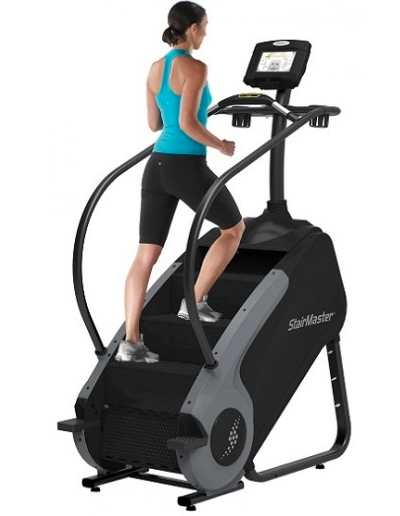Stairmaster vs. Stationary Bike
Share This

Need your cardio fix, but not sure whether the stationary bike or stairmaster is the better bet? Both the exercise bike and stair stepper offer cardiovascular benefits, but multiple factors may send you stepping or pedaling depending on what your body needs. Choosing between the stepper and the bike will mean the difference between using your own weight against you or taking it out of the picture completely. Your joints might prefer one exercise while your waistline, or, muscular endurance may prefer the other.Your glutes, hamstrings, quadriceps and calves will all be sufficiently taxed after spending some time on either machine, but one may be suited better for you than the other.
Bikes
Exercise bikes come in two forms, recumbent and upright. Both are non-weight bearing, meaning you do not have to support your own weight while exercising. The non-weight bearing nature of the stationary bike makes it ideal for athletes recovering from injury or exercisers with joint pain. The bike also varies between hills, slopes, and intervals while still providing a progressive and challenging load as the pedals become harder to turn as the intensity increases.

The stairmaster is a weight bearing machine, meaning that you must stand and support your weight during exercise. Steppers offer similar programs to bikes, but the intensity comes from the steps falling faster while you keep up pace. Because the stair climber is used in an upright, standing position, your back and abdomen will also work throughout your workout to stabilize and support your upper body. What does this mean practically? Increased activation in the glutes which most helps prevent injury in decelerative states.

Calories Burned
The stationary bike and stair climber are both effective ways to burn calories, but once again the bike slightly elbows out the stair climber. According to Harvard Health Publications, a 155-pound person will burn about 260 calories riding a stationary bike at a moderate intensity for 30 minutes, while that same person would burn only 223 calories using a stair climber for 30 minutes.
On the contrary, some fitness practitioners believe the stairmaster produces a higher heart rate during exercise than when using bikes when programmed at a higher intensity, resulting in more calories exerted the harder you push.
The Break-Down
Exercise Bike
Pro: The exercise bike offers good cardiovascular training for people that require non-weight bearing exercise. Exercise bikes are recommended for people with joint issues because there is less pressure on the knees, ankles, and low back when compared to the stair stepper.
Con: Since the exercise bike is a non-weight bearing activity, it does not help to strengthen or protect your bones. According to a 2012 study published in BMC Med, even at sports competition levels, cycling does not provide any benefit to bone health. When comparing multiple indoor cardio machines for energy expenditure at the same participant effort level, the exercise bike leads to fewer expended calories than other machines.
Pro: Both types of machines offer a low-impact workout. The stationary bike, however, wins out on this category because it has virtually no impact. This makes it appropriate for nearly every fitness level as well as any physical condition such as injury, arthritis, osteoporosis or obesity.
Pro: If on the other hand you enjoy the social aspect of working out, then the stationary bike may be your weapon of choice. Most gyms offer Spinning classes which consist of high-intensity cycling in a group atmosphere.
Con: if you aren’t positioned properly on the bike, you can injure your hamstring muscles and lower back.
Stairmaster
Pro: The stairmaster promotes healthy bones and joints because of the consistent pressure being placed on them during the exercise. Stairmasters could be associated with a higher heart rate during exercise than when using bikes, resulting in more calories burned while at the same level of exertion.
Con: While you can get a good workout from the stairmaster, becoming accustomed to it can take some time. Many people lean onto the side rails, which makes the exercise easier but reduces the benefits. Unlike the stairmaster, the bike is extremely easy to use and there are few ways to cheat the benefits.
Pro: If you opt for any other stationary bike other than a recumbent, which has full back support, you will have the opportunity to get some upper-body work in on your back and shoulders, as they support your upper body.
Con: While the stairmaster is relatively low impact, it’s not appropriate for someone with a lower-body injury or who may have balance issues.
Get Down to Business
If you’re considering using the stairmaster, or a stationary bike, take the time to compare and see which is a better option for your body based on your objectives and what you actually enjoy. The elliptical may have some benefits as well, check out this article explaining the best ellipticals and them vs. the treadmill. Once you’ve decided which type of exercise machine is better for you, it’s time to get to work. The American Council on Exercise recommends that healthy adults under age 65 get 30 minutes of moderate cardio exercise 5 days a week, or 20 minutes of vigorous exercise 3 days a week. You can do an entire workout at once or break it up into 10-minute segments throughout the day. If you’re new to exercise, ease your way into the recommendations, gradually increasing your workout time or intensity. Taking any of these workouts outside may even enhance results further. There is an abundance of interesting visual stimulus outside, which leads to burning more calories, so don’t be afraid to run the bleachers or convention stairs, or go on a bike ride!
